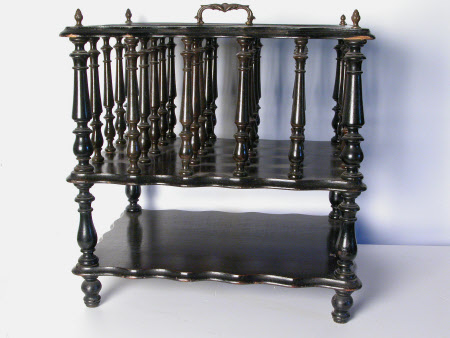Canterbury
Category
Furniture
Date
Unknown
Materials
Brass, Wood
Measurements
467 x 450 x 340 mm
Order this imageCollection
Greys Court, Oxfordshire
NT 195573
Summary
Wooden Canterbury with four vertical sections above a single shelf, all connected with turned spindle columns in ebonised wood, with four brass acorn finials on each corner of the top, and a brass handle in the top centre. Circa 1850.
Full description
Wooden Canterbury with four vertical sections above a single shelf, all connected with turned spindle columns in ebonised wood, with four brass acorn finials on each corner of the top, and a brass handle in the top centre. Circa 1850. A Canterbury is a low, open topped stand with slatted partitions, and a drawer beneath, sometimes with short legs on casters, designed for holding sheet music. The highly portable Canterbury with casters and hand hole could be easily lifted or rolled along the floor. Originally found in England during the 1780s, they were made in mahogany from about 1800, and later in rosewood and walnut. According to Thomas Sheraton (who popularized the Canterbury in his publications) the reason for the name is that "A bishop of the see first gave orders for those pieces". He also suggested that they be slid underneath the piano forte. By the 1860s, the Canterbury was considered a status symbol within wealthier American homes.
